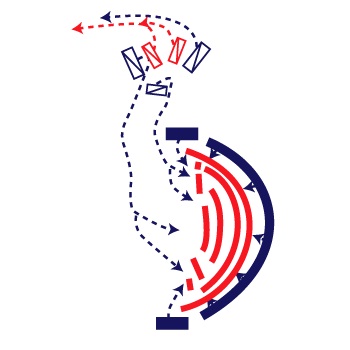40K TACTICS: Maneuver Warfare


Some people believe that combat should be an honorable duel between two equally matched foes on an open plain. I am not one of those people.
What is Maneuver Warfare
Broadly, there are two types of warfare: maneuver and attrition. Attrition warfare relies on the principles of mathematics; whoever has the most men, morale, and materiel wins the battle. Maneuver warfare brings other concepts to the table, namely movement, to change the balance of the encounter. In reality, warfare is rarely exclusively attrition or maneuver, and is instead a mix of the two. In 40k, most games slide toward the attrition side; some games are almost entirely attrition (I’m looking at foot slogging boyz, gaunt hordes, and most guard lists). Maneuver warfare in 40k is used to achieve certain objectives characterized by these catchphrases: taking the initiative, local superiority, and defeat in detail. In reality (and other games), maneuver warfare is also more commonly used to flanking or envelop the enemy, but besides destroying a retreating unit and hitting vehicle side armor, flanking and envelopment isn’t terribly useful in 40k.
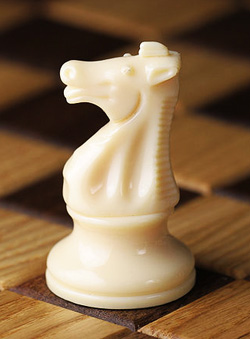 |
| Speaking of maneuver warfare |
Why Maneuver Warfare
When you take the initiative in the game, you change it up from responding to your opponent’s moves to having the opponent respond to yours. If all the opponent can do is respond to you, you will always get the first strike and deal the largest blow. You decide what units fight and you decide when and where they fight. While 40k is not a rock-paper-scissors game, there are certain units better at defeating others in certain situations. Maneuverability allows your assault units to gain the charge bonus and allows them to close with a heavy weapons squad to take them out without receiving as much return fire. The opponent can then react to you later, but it’s too late at that point; the assault unit has done its job, the heavy weapons squad is dead. In a turn-based game like 40k, gaining the initiative is a huge bonus. This is what Sun Tzu refers to as potential energy; the ability to utilize your force’s greatest (potential) strengths while nullifying your opponent’s ability to use his greatest strengths. Going first gives that player an advantage in actually obtaining the initiative in the game, but when the second player gains the initiative (not by “stealing” it through the d6 roll), that’s when things can start to get interesting. Taking the initiative also allows the maneuvering side to take advantage of terrain in the center of the field, either to use that terrain or to deny it to the enemy, or perhaps both.
Having local superiority means having an advantage on a portion of the battlefield, while often having a weakness in another. A maneuverable force can position itself such that is has an overwhelming advantage on one side of the battlefield while having no forces at all on the other side, meaning it is essentially an entire army of units against maybe half an army for a few turns. Clausewitz calls this “mass,” essentially creating as dense of a formation as possible in order to naturally cause local superiority wherever you fight. Shooting units on mobile platforms can create a situation by positioning themselves behind LOS (Line of Sight) blocking terrain or vehicles such that they can only see one or two enemy units, while blocking LOS to the rest of the enemy army. Those shooting units combine their firepower to utterly destroy those enemy units and in the opponent’s turn, they take no return fire (or return fire through cover in a worst case). Another example could be a “refused flank” deployment, a deployment in which your forces are disproportionately deployed to one side of the table… preferably all your forces are on one side of the table. If you’re deploying second, this is much easier to achieve as you can see your opponent’s deployment, but if you’re deploying first, a fast army with the help of Eldrad or the Deceiver (for another month or two at least) can help redeploy large portions of your army from one flank to the other. Clever deployment, such as deploying slower units in the middle with faster units on the flank can allow you to choose which side you “redeploy” on the first turn. The side you want to make strong is the side furthest from your opponent’s slow and/or short ranged units (devastators, long fangs, demolishers, broadsides, walkers, etc) and is the side that hopefully has objectives on it. The disadvantage to local superiority in a game like 40k is that you have to weaken one side in order to strengthen another, due to the relatively even forces. As mentioned earlier, the way to solve this problem is instead of weakening a side, you completely remove that side, thus making half of your opponent’s army useless for a portion of the game.
The end goal of maneuver warfare is often to defeat your opponent’s forces in detail; it is not to simply get your forces into contact with the opponent’s forces faster. By obtaining local superiority, it is not just probable that you will destroy a portion of the opponent’s forces quicker, but it is also probable that your forces will take proportionately less damage in return. By taking the initiative and contacting the enemy first, it is entirely possible that with a large amount of local superiority, you can wipe out that portion of the enemy’s forces without receiving any damage in return. Defeating the opponent in detail means to gain local superiority, take out a portion of the enemy’s forces, and move on to the next portion. Rinse and repeat until the opponent is defeated. It is a simple concept, but achieving it takes a little more work.
How to Fight?
An enemy that knows you possess the maneuverability advantage has several options. The first is to use his relatively cheaper (less points paid for maneuverability) and thus more numerous troops to try and trap you with an envelopment. This is not a terribly good idea in 40k as the rules mechanics simply do not give much of an advantage to an enveloping army, while causing that army to naturally spread out and thus give the enveloped army an opportunity for local superiority along either side of the opponent’s line. The second option is to concentrate his forces in a corner, wrapping successively less important units around the more important ones. I call this tactic “circling the wagons” which is a term that originally comes from back in the wild west of America where, when attacked or at night, the convoy would circle their wagons to provide mutual protection from their faster-moving attackers. The term and the tactic is still used today to protect convoys. It is essentially the exact opposite of an envelopment, attempting to ensure that no part of the force becomes isolated from the rest of the army. The answer to this tactic is to NOT charge into the mass. Instead, drop pie plates on them until they die or disperse, then get into contact with one side of the dispersed formation to attack it in relative safety while your artillery continues to drop fire on the other side. What you want to do is only give your opponents dilemmas, not problems. Problems can be solved, dilemmas have no favorable outcome… so in this case, they can either clump together and take an artillery bombardment all game while you take objectives or they can spread out to lessen the effect of the pie plates and lose their Clausewitzian “mass.” Third, the opponent could deploy his long ranged and slow firepower in the middle with his own maneuverable assets on the flanks, like a maneuverable player would. There is no easy solution to this as you are both essentially doing the same thing; however, you should have the advantage as your maneuverable forces should be superior to your opponent’s, which is the whole point of your list.
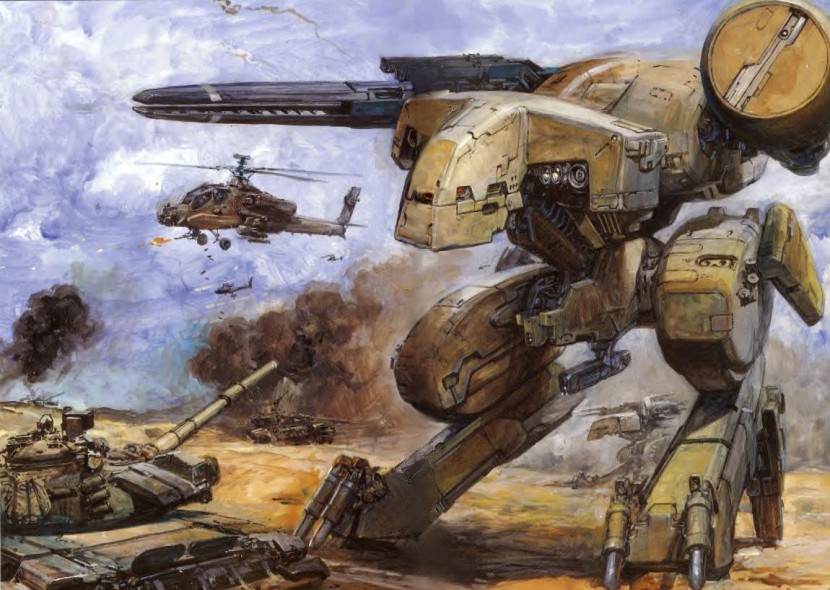 |
| Mobile and survivable artillery |
Assembling a Maneuver List
Discussing the use of artillery in dispersing the enemy brings me to army selection when creating a mobile force to utilize in maneuver warfare. You want to think about combined arms and synergy; if possible, take a mix of mobile units that fulfill different roles, but also support each other. An entirely jump pack army, Blood Angels DoA (Descent of Angels) style, is very rock-paper-scissors in that it will devastate some armies, and die horribly to others. A DoA army simply does not have the tools to win some matches, which is why a combined arms list is ideal. For Blood Angels, a list with Vindicators to disperse the enemy formation, Baal Predators for mobile firepower, and an assault unit or two to deal massive amounts of damage is better. What would be even better is a BA deathstar of some sort (Mephiston by himself, Dante + priest + death company, etc) as the only combat unit in the army, supported by mobile fire support and Vindicators. Necrons also, surprisingly, do this well with monoliths or heavy destroyers, destroyers, and the Deceiver. Daemons can do it with soul grinders, greater daemons or blood crushers, and tons of Tzeentch things. Other armies have various success with this as well; Eldar for example, can use fire prism tanks, a jetbike seer council, and more mobile firepower, although their combined arms isn’t as effective because of their unit selection. Generally the mobile firepower should be the core of a maneuvering army list. The mobile firepower does the heavy lifting and maneuvering, it should be at least 1/3 of your points. The artillery, which is optional but recommended to break up dense formations, should be used to support the mobile firepower. The deathstar is really more like a super star destroyer if we want to continue with Star Wars metaphors; it’s not 90% of your force like in Episode IV, but it’s a good chunk of it, maybe 20-25% at most of your point total, much like the Executor in Episode V. The “deathstar,” like the artillery, supports your mobile firepower. Finally you need some kind of objective taker if you can’t incorporate that into one of the other three categories.
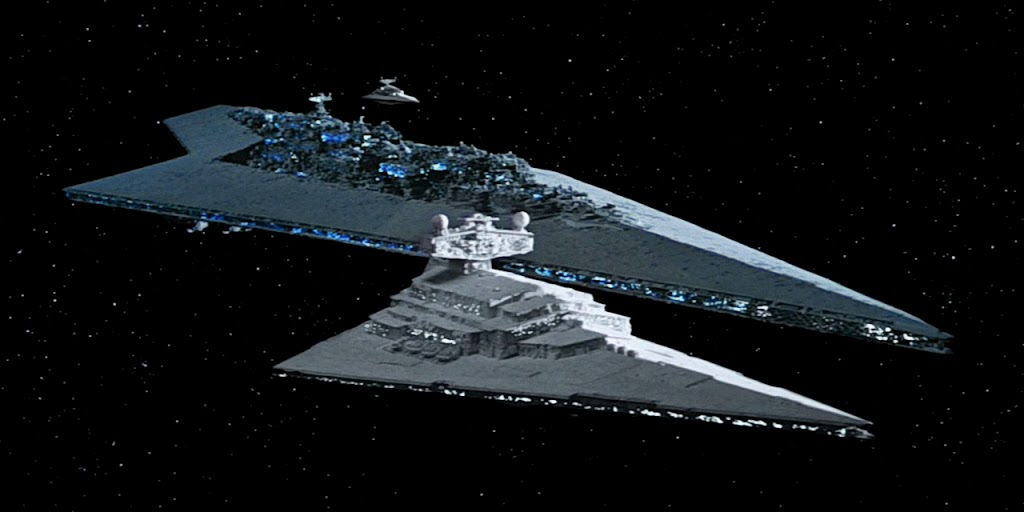 |
| The Super Star Destroyer Executor, smaller than the Death Star |
Unit Selection Pros and Cons
When selecting units for a combined arms maneuvering force, there are a few things to take note of. 40k uses a point system to rate the effectiveness of a unit or model. Higher points roughly equates to higher effectiveness, which means that taking a high point unit creates a natural local superiority wherever that unit goes on the battlefield. Thus, the reason deathstars are effective if used properly. But you can’t just take a unit, give it all the bling, and call it effective. The unit has to generally have speed, killing power, and survivability. If it’s a shooting unit, the unit has to be able to move and fire, to be able to move 12″, if not more when needed, and can take a few hits. A viper jetbike has great firepower with decent accuracy, amazing mobility, but is extremely fragile. A baal predator has decent firepower with great accuracy, good mobility, and good survivability (Av13), making it a natural choice. A baal predator is not the ideal mobile firepower because it has too little killing potential relative to the size of the unit and multiple baal predators block LOS from each other. A squadron of attack bikes with plasma cannons, if such a unit existed, would be pretty much perfect (making them jetbikes would make them perfect). A monolith has good firepower, amazing survivability, but pretty pathetic mobility… however, it can deep strike, it can block LOS, and it can increase the mobility of your other units, making up for its own weaknesses. The reason Eldar struggle with this concept is that they lack survivable mobile firepower besides the fire prisms. They can make it work, but it’s more difficult in that they lack a good core for their list.
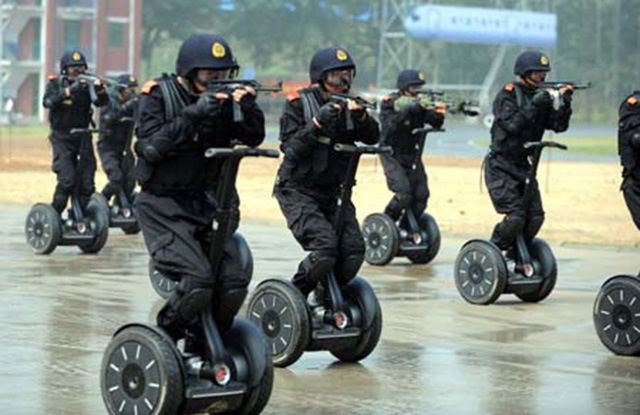 |
| This unit has mobility, firepower, and survivability |
Why Shooting Focused?
The reason that maneuver warfare requires a lot shooting in this game is a fair question. Assume you divide your opponent’s forces and you charge one side of them, and say you wipe them out. That would leave you most likely within firing range of your opponent, but not within charge range to follow up your attack, meaning you just traded part of their force for part of your force. And since you’re paying for mobility but your opponent is not, that trade was most likely a bad one. Yes, on the turn an assault marine charges, he deals 2-3 the damage that a tactical marine does (depending on opponent’s armor save and WS), but that assault marine also takes return hits if some of the enemy unit lives and can be in a very bad position after the combat ends. Also, if an assault unit does not finish off the enemy, it could be stuck in combat for a while where you essentially lose control of that unit. When the majority of your army is ranged, you can divide your opponent’s forces and eliminate that portion without being in range of the other portion, which you can then finish off on your own terms. Thus, you want your shooting elements to have at least 24″ range, but preferably 36″ or more. But why take a close combat deathstar unit, besides that it’s a natural concentration of points? First because they have utility beyond close combat; for example, the Deceiver can redeploy your army and essentially create a 12″ no-man’s land where almost anything (besides wraithguard) that gets within 12″ will die a horrible death while Mephiston and a jetbike council provide psychic support and as well as defense. Their second use is to chase down, engage, and destroy your opponent’s mobile assets, like bikers or jumpers. These mobile assets are intended to disrupt your maneuvering by employing suppressive fire, destroying your transports or back line, or getting into melee to stop you in your tracks. In the Battle of Cannae, before Hannibal could successfully envelop and destroy the vastly more numerous Roman forces, he had to first drive off the Roman cavalry. Once he did so, he maneuvered his forces to encircle the Romans and almost completely annihilated the eight legions arrayed against him (see the first picture). While encirclement doesn’t work terribly well in 40k due to the rules, the concept of removing your opponent’s means of catching and disrupting you to gain a firm advantage in maneuverability is the key to winning most of your battles. You want to do this quickly and without receiving too many casualties, so the quick combat deathstar has a use when applying maneuver warfare.
A note on MSU Lists
While I didn’t originally intend on covering MSU lists, they’ve become the default archetype in many areas, so I feel like I must address them. MSU lists generally have a large footprint on the table and are thus cumbersome and difficult to maneuver. Further, the contents of the transports are themselves slow and require effort to mount or dismount from their transports, limiting the tactical options of the MSU player. The point of MSU is to maximize the amount of firepower provided by transports like the razorback or immolator while creating target saturation such that target priority is difficult. Maneuverable fire support, like Necron destroyers, can maneuver to the edges of the enemy formation and take out a few transports at a time while minimizing, or completely eliminating, return fire due to the MSU player’s own tanks being in the way. This is, essentially, local superiority by list design.
What is your experience with maneuver warfare? Do you prefer to face your enemy head on without any tricks? Does the phrase “waaaaaagh” comprehensively describe your battle plan? Does 40k have no strategy nor tactics?

